Male population dominated the projected mid-year population in Central Visayas from 2021 to 2025
For 2021, projected mid-year population of Central Visayas was estimated at 8,054,772. By 2025, the region’s population was projected to reach 8,391,707. (Table 1)
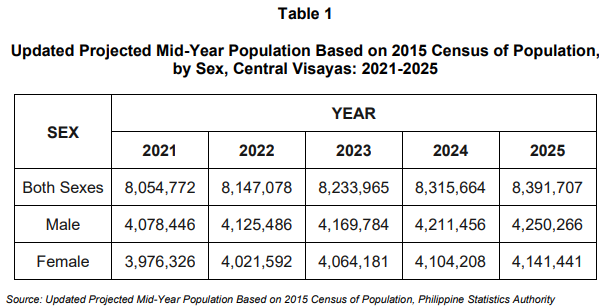
Female population in 2021 was estimated at 3,976,326 or about 49.4 percent of the total projected mid-year population in Central Visayas. Meanwhile, male population was estimated at 4,078,446 or 50.6 percent of the total projected population.
Male population dominated the projected mid-year population in Central Visayas from the year 2021 to 2025.
Employment rate among Women in Central Visayas was higher compared to Men from 2017 to 2018
Generally, there are more economically active men than women from 2017 to 2018 in Central Visayas. In 2018, 59.4 percent of men are in the labor force as compared to the 40.6 percent of women. (Table 2)
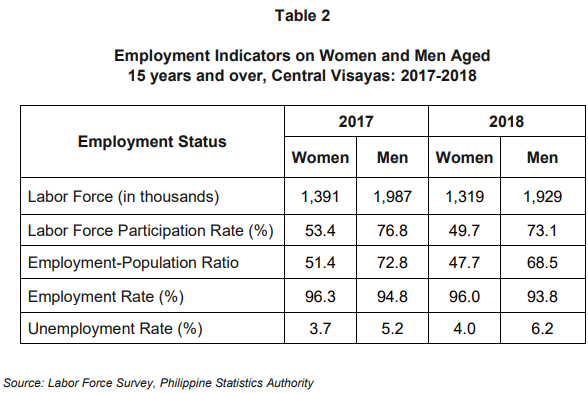
Meanwhile, employment-population ratio highlights gender differential in employment status. In 2018, only 47.7 percent of women compared to 68.5 percent of men were employed.
Employment rate for women in Central Visayas was higher at 96.0 percent compared to that for men at 93.8 percent in 2018. The same trend can be observed in 2017.
Unemployment rate for men and women in 2018 stood at 6.2 percent and 4.0 percent, respectively.
It can be noted that employment rate of both sexes slightly decreased from 2017 to 2018. Moreover, employment rate gap between women and men is wider in 2018 compared to 2017.
In 2018, more women were employed as managers compared to men in Central Visayas. Among the employed men, mostly were employed in elementary occupations at 25.8 percent. The other major occupation groups where many men were employed are: Skilled Agricultural, Forestry and Fishery Workers; Craft and Related Trade Workers; and Plant and Machine Operators and Assemblers.
Among the employed women in Central Visayas, mostly were service and sales workers at 23.7 percent. This was followed by elementary occupation at 20.7 percent. Other major occupation groups where most women were employed are: Managers, Skilled Agricultural, Forestry and Fishery Workers, and Clerical and Support Workers.
The largest proportion of employed women were engaged in Wholesale and Retail Trade; Repair of Motor Vehicles and Motorcycles with 28.3 percent. On the other hand, most of the employed men were in Agriculture, Hunting, and Forestry with 19.7 percent. (Table 3)
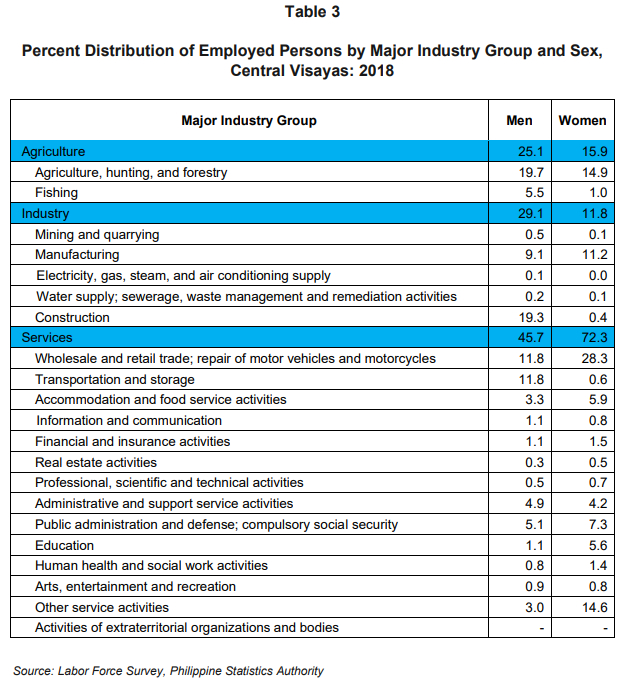
In 2019, more men were working or had worked abroad during the past six months with 60 percent compared to women with 40 percent. (Figure 2)
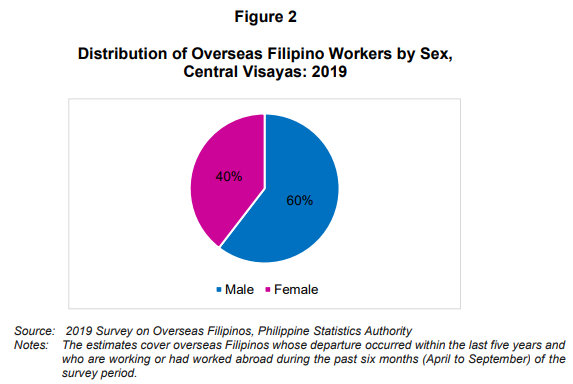
Simple and Functional Literacy for women in Central Visayas relatively higher, many were Academic Degree Holders compared to men
Ninety-three (93) of every 100 individuals in Central Visayas aged five (5) years old and over are basic literate in 2019. Females posted higher basic literacy of 94.5 percent compared to males with 92.4 percent. (Table 4)
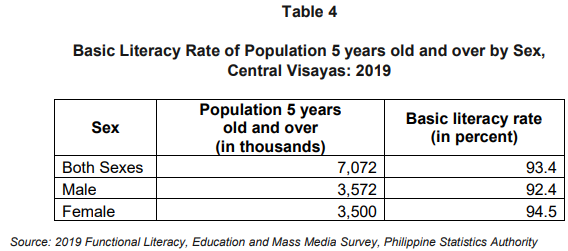
For population 10 years old and over in Central Visayas, basic literacy rate for both sexes registered at 95.8 percent in 2019 which was lower than the 96.2 percent in 2013. In addition, basic literacy rate among women remained higher than among men in 2019 and 2013. (Figure 3)
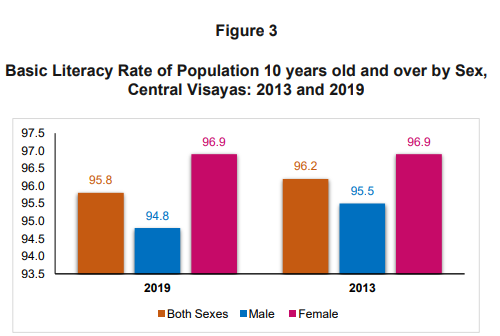
Of the 5.8 million population 10 to 64 years old in the region, 5.2 million were considered functional literate at 89.1 percent in 2019. The functional literacy rate among females with 91.0 percent was higher than among males with 87.2 percent.
Generally, functional literacy rates among the population 10 to 64 years old across sexes were higher in 2019 than in 2013. Functional literacy rate in 2019 with 89.1 percent was higher compared with 87.3 percent in 2013.
TECHNICAL NOTES
Basic Literacy
- is the ability of a person to read and write with understanding a simple message in any language or dialect.
Basic Literacy Rate
- the percentage of population which can read and write a simple message in any language or dialect.
Employed
- include all persons 15 years old and over as of their last birthday and during the basic survey reference period are reported as either: a) At work. Those who do any work even for one hour during the reference period for pay or profit, or work without pay on the farm or business enterprise operated by a member of the same household related by blood, marriage, or adoption; or b) With a job but not at work. Those who have a job or business but are not at work because of temporary illness/injury, vacation, or other reasons. Likewise, persons who expect to report for work or to start operation of a farm or business enterprise within two weeks from the date of the enumerator's visit, are considered employed.
Employment Rate
- Percentage of the total number of employed persons to the total number of persons in the labor force.
Employment – to – Population Ratio
- Ratio of employed persons to the total population 15 years old and over
Functional Literacy
- is a significantly higher level of literacy which includes not only reading and writing but also numeracy skills. The skills must be sufficiently advanced to enable the individual to participate fully and efficiently in activities commonly occurring in his life situation that require a reasonable capability of communicating by written language. A functional literate person is one who can at least read, write, compute and/or comprehend. Also, persons who graduated from high school or completed higher level of education are classified as functionally literate.
Labor Force, (Persons in the)
- the population 15 years old and over whether employed or unemployed who contribute to the production of goods and services in the country.
Labor Force Participation Rate
- Percentage of the total number of persons in the labor force to the total population 15 years old and over.
Occupation
- Type of work a person does to earn his living.
Notes:
- The following are the major occupation groups: officials of government and special-interest organizations, corporate executives, managers, managing proprietors and supervisors; professionals; technicians and associate professionals; clerks; service workers and shop and market sales workers; farmers, forestry workers and fishermen; trades and related workers; plant and machine operators and assemblers; laborers and unskilled workers; and special occupations. This term is used for disaggregating other labor and employment measures, e.g., total number of employed persons by major occupation groups.
Overseas Filipino Worker (OFW)
- a Filipino worker who is to be engaged, is engaged, or has been engaged in a remunerated activity in a country of which he/she is not a legal resident.
Population
- total number of individuals in a territory at a specified time. It covers both nationals and aliens, native- and foreign-born persons, internees, refugees and any other group physically present within the borders of a country at a specified time. In assembling national demographic statistics for publication, the basic aim has been to obtain data for the physically present (or de facto) population rather than for the legally established resident (or de jure) inhabitants
Population Projection
- computation of future changes in population numbers, given certain assumptions about future trends in the rates of fertility, mortality and migration. Demographers often publish high, medium, and low projections of the same population based on different assumptions of how these rates will change in the future
Unemployed
- The unemployed include all persons who are 15 years old and over as of their last birthday and are reported as:
- without work, i.e., had no job or business during the basic survey reference period;
- and currently available for work, i.e., were available and willing to take up work in paid employment or self-employment during the basic survey reference period, and/or would be available and willing to take up work in paid employment or self-employment within two weeks after the interview date;
- and seeking work, i.e., had taken specific steps to look for a job or establish a business during the basic survey reference period;
- or not seeking work due to the following reasons:
- tired/believe no work available, i.e., the discouraged workers who looked for work within the last six months prior to the interview date;
- awaiting results of previous job application;
- temporary illness/disability; (d) bad weather; and (e) waiting for rehire/job recall.
Unemployment Rate
- Percentage of the total number of unemployed persons to the total number of persons in the labor force.
Work
- Any activity that a person does during the reference period, for pay in cash or in kind, in any establishment, office, farm, private home, or for profit or without pay on a family farm or enterprise. It also includes:
- what a farm operator or member of the operator's family does on the farm operated by another household on exchange labor arrangement; and
- any activity that a person does in relation to minor activities in home gardening, raising of crops, fruits, hogs, poultry, etc., fishing for home consumption and manufacturing for own use. However, there must be some harvest in the case of home gardening, raising of crops, fruits and nuts, and gathering of wild fruits and vegetables; animals disposed of (sold, consumed, bartered, or given away), or some catch in fishing in order that these activities will be considered work.
Approved by:
ARIEL E. FLORENDO
Regional Director

